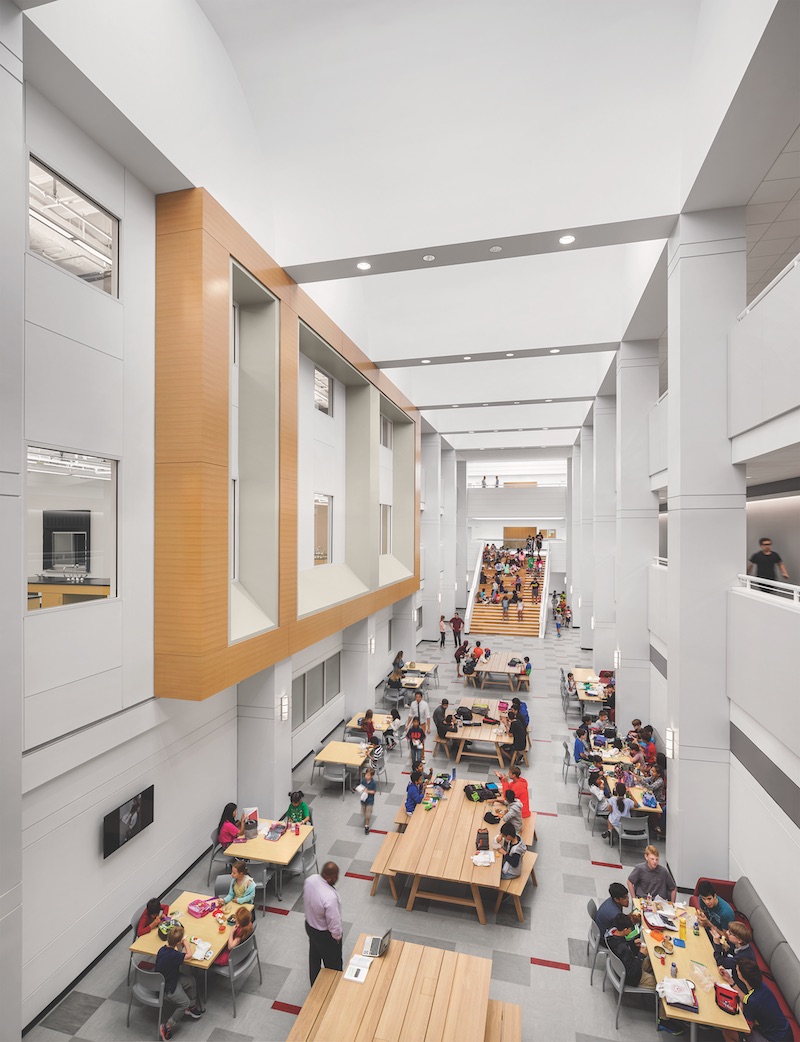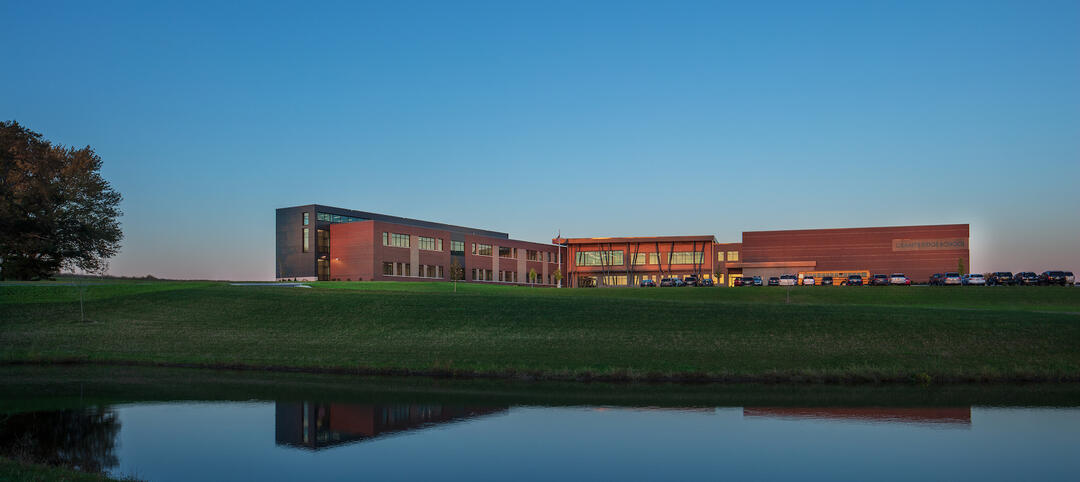The average age of the 84,000 public elementary and secondary schools in the U.S. is 44 years since construction, and 12 years since a major renovation, according to the Department of Education. School districts, say AEC experts, are more inclined than ever to tear down old schools and build new with the latest technological and security systems.
Older schools, with their small windows and rooms and creaky infrastructure, are tough and expensive to retrofit. That may explain why more school districts, when they choose to renovate, are preferring to adapt vacant buildings in their communities for reuse as modern schools.
And boy, are there a lot of vacant buildings out there. In the greater Washington, D.C., region alone, there’s over 70 million sf of unused office space. In Dallas, 30 million sf of offices sit empty, and 17 million sf in Phoenix. To say nothing of the hundreds of millions of retail square footage that e-commerce has rendered superfluous.
For example, last February, a former Kmart in Waukegan, Ill., became home to the 53,000-sf Cristo Rey St. Martin College Prep, an $18.5 million adaptive reuse project that JGMA designed and McShane Construction built, with 18 classrooms, three science labs, a cafeteria, library, and administrative offices for 400 students.
See Also: Making schools more secure is imperative, but how best to do that isn't settled yet
Adaptive reuse “is becoming a more established option for educational program space,” say the authors of a new white paper from Perkins Eastman, “Commercial Conversion: Adaptive Reuse, A Catalyst for Educational Innovation.” One reason is that schools are scrambling to keep pace with growing student populations. More than 31% of school sites include temporary buildings.
Culling from its own K-12 portfolio, Perkins Eastman provides case studies of creative adaptive reuse. In New York’s Chelsea neighborhood, Avenues: The World School of New York took a 215,000-sf, 1920s-era warehouse with 20,000-sf floor plates and converted it into a pre-K-12 school for 1,600 students. The building already had abundant windows on all four sides. But the classrooms had to be smaller than is typical because of the interior columns’ 20x20-foot spacing.
Other case studies—in New Jersey, Dallas, northern California, and northern Virginia—offer various adaptive scenarios, such as:
• a multitenant office tower where the school occupies the lower floors
• a former Verizon call center to which 30,000 sf was added over two floors for a private school for children and young adults with learning and behavioral disabilities
• a former corporate headquarters, whose deep, 120,000-sf floor plates are arranged around a series of atrium spaces, became the central organizing feature of a school.
In El Segundo, Calif., Balfour Beatty Construction Services recently completed the construction of a Gensler-designed project for the Wiseburn Unified School District and Da Vinci Schools, which converted a 330,000-sf former Northrup Grumman aerospace facility on 14 acres into three charter schools—collectively known as Wiseburn High School—on three floors with 72 classrooms and 210,000 sf above administrative offices.
David Herjeczki, AIA, LEED AP, a Design Director and Principal with Gensler, told the Daily Breeze newspaper that this $160 million project, which opened in December 2017 and serves 1,350 students, was the first of its kind to make it through the Division of State Architect approval process. The project came about after Wiseburn, a former K-8 district, won unification in 2014 and chose to partner with Da Vinci rather than build its own high school.
Herjecki explained that the idea was to build a nontraditional school whose learning environments reflect the professional world. Da Vinci Science, on the second floor, includes an engineering lab; Da Vinci Design, on the top floor, has a fabrication lab. Da Vinci Communications is located on the third floor.
Each of the three high schools has a retractable door that rolls up onto an outdoor patio. There are no corridors or lockers, and many of the walls are movable. The classrooms have rearrangeable desks, a science lab, and collaborative spaces. The building’s floor-to-ceiling windows offer transparency and views of the surrounding city.
A gym, soccer fields, and shared aquatics center were scheduled for completion this summer.
Related Stories
School Construction | Oct 31, 2022
Claremont McKenna College science center will foster integrated disciplinary research
The design of the Robert Day Sciences Center at Claremont McKenna College will support “a powerful, multi-disciplinary, computational approach to the grand socio-scientific challenges and opportunities of our time—gene, brain, and climate,” says Hiram E. Chodosh, college president.
University Buildings | Oct 27, 2022
The Collaboratory Building will expand the University of Florida’s School of Design, Construction, and Planning
Design firm Brooks + Scarpa recently broke ground on a new addition to the University of Florida’s School of Design, Construction, and Planning (DCP).
Higher Education | Oct 24, 2022
Wellesley College science complex modernizes facility while preserving architectural heritage
A recently completed expansion and renovation of Wellesley College’s science complex yielded a modernized structure for 21st century STEM education while preserving important historical features.
BAS and Security | Oct 19, 2022
The biggest cybersecurity threats in commercial real estate, and how to mitigate them
Coleman Wolf, Senior Security Systems Consultant with global engineering firm ESD, outlines the top-three cybersecurity threats to commercial and institutional building owners and property managers, and offers advice on how to deter and defend against hackers.
Education Facilities | Oct 13, 2022
A 44-acre campus serves as a professional retreat for public-school educators in Texas
A first-of-its-kind facility for public schools in Texas, the Holdsworth Center serves as a retreat for public educators, supporting reflection and dialogue.
K-12 Schools | Sep 21, 2022
Architecture that invites everyone to dance
If “diversity” is being invited to the party in education facilities, “inclusivity” is being asked to dance, writes Emily Pierson-Brown, People Culture Manager with Perkins Eastman.
| Sep 14, 2022
Indian tribe’s new educational campus supports culturally appropriate education
The Kenaitze Indian Tribe recently opened the Kahtnuht’ana Duhdeldiht Campus (Kenai River People’s Learning Place), a new education center in Kenai, Alaska.
Architects | Sep 12, 2022
FWA Group joins national architecture, interior design, and planning firm Hord Coplan Macht
Hord Coplan Macht acquires FWA Group.
| Sep 7, 2022
K-8 school will help students learn by conducting expeditions in their own communities
In August, SHP, an architecture, design, and engineering firm, broke ground on the new Peck Expeditionary Learning School in Greensboro, N.C. Guilford County Schools, one of the country’s 50 largest school districts, tapped SHP based on its track record of educational design.
Giants 400 | Sep 1, 2022
Top 100 K-12 School Contractors and CM Firms for 2022
Gilbane, Core Construction, Skanska, and Balfour Beatty head the ranking of the nation's largest K-12 school sector contractors and construction management (CM) firms for 2022, as reported in Building Design+Construction's 2022 Giants 400 Report.

















